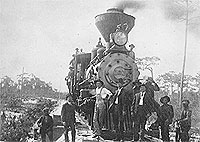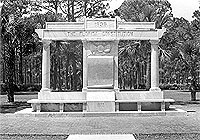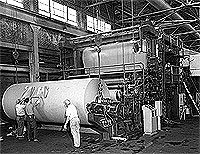|
Regional History History of Timbering County Histories Calhoun County Franklin County Gadsden County Gulf County Photos Maps Jackson County Liberty County Wakulla County |
History: Gulf County
1829 - The settlement of St. Joseph was established on the eastern shore of St. Joseph Bay.
1834 - The Lake Wimico and St. Joseph Canal Company was formed.
A plan for Lake Wimico and St. Joseph Canal was devised to link the Chipola and Apalachicola Rivers with St. Andrews Bay near St. Joseph.
1835 - Colin-Mitchel Supreme Court decision regarding the validity of the Forbes Purchase
Indian Chief, Hopoelithle Micco with permission of the Spanish Governor in 1803, had ceded over a million acres of land from the St. Marks River to the Apalachicola River, including the adjacent islands and sixty miles into the interior, to the John Forbes and Company. This was a settlement for damages done to the Panton, Leslie Company (a predecessor to John Forbes and Company) by the Indians under the investigation and leadership of Buccaneer, William Augustus Bowles. The United States Supreme Court ruled in favor of the John Forbes and Company (which later became known as the Apalachicola Land Company) on March 17, 1835 making all property holders in Apalachicola liable for settlement to the Apalachicola Land Company. The extensive plans of the Apalachicola Land Company attracted labor and money to Apalachicola and land prices soared due to speculation. Rather than paying the settlement, many of the residents of Apalachicola decided to develop the new town of St. Joseph, which was just outside the limits of the Forbes Purchase and the control of the Apalachicola Land Company, and deviate the river's commerce away from Apalachicola. Buildings, wharves and trading facilities were erected and the new town grew.
1835 - Lake Wimico and St. Joseph Canal Company incorporated
The Lake Wimico and St. Joseph Canal Company was incorporated by the Legislative Council of the Territory of Florida. This was the first step by the businessmen of St. Joseph to divert river traffic to the new deep-water port.
1838 - Florida's first constitutional convention held in St. Joseph
The first Constitutional Convention of Florida was held in St. Joseph (Calhoun County at that time) from December 3, 1838 until January 11, 1839. Delegates in the convention drafted a constitution that was accepted by a vote of 50 to one. The State of Florida was governed by this document until the Civil War broke out, even secession brought very little changed to the state's first constitution.
1839 - St. Joseph & Iola Railroad put into operation
Railroad passenger transportation rates between the two points, St. Joseph and Iola, were $1.00 for adults and 50 cents for children under 12 years of age. The fee for transporting a bale of cotton was 15 cents, the lowest in proportion to other goods due to the fact that businessmen were attempting to establish St. Joseph as a “Cotton Exporting City”. Despite the publicity, huge investments, and addition of new locomotives, wharves and warehouses along the line, rival city Apalachicola still exported the majority of the bumper cotton crop for the 1839 season. The founders of St. Joseph had tried in vain to make their venture a success.
1840 - Calhoun Course opens in St. Joseph
This mile-long horse racing track opened in February of 1840, but was only open for the seasons of 1840-41 due to the carryover from the banking panic that swept the country in 1837 causing all races to be canceled for the 1842 season. The track was one of the most popular gathering places for many of the territory's most prominent citizens. The track was located just off of CR-30A near its present-day intersection with West Rutherford St. The palm trees on the site are said to be where the grandstands were located.
1841 - Yellow Fever strikes St. Joseph
The resort city of St. Joseph attracted many visitors from the plantations and cities of lower Georgia and Alabama with its cool breezes and beautiful beaches that summer. Daily rain showers filled the swamps in the area and mosquitoes were breeding rapidly. By August of 1841, mosquito-borne Yellow Fever had struck and killed about 75% of the residents of St. Joseph and many of its seasonal visitors, leaving the town nearly empty. It was rumored that the epidemic was brought into the area by boat. During the journey the boat's captain had died from the disease and the crew stopped at St. Joseph to bury the body, unknowingly introducing the disease to the area. To add to the demise of St. Joseph, a disastrous hurricane hit on September 14 of that year, followed by fires that swept through the town and forests in the fall.
1844 - Hurricane demolishes what was left of St. Joseph
With the passing of the Yellow Fever epidemic a few residents attempted to return to the devastated city to rebuild, but with the collapse of real estate values and mortgages being foreclosed, they faced a bleak future. Some people took their movable property and attempted to escape to Texas, which did not belong to the United States at the time, others moved across the bay, and a few hardy souls remained in the once thriving city to face yet another disaster. Residents of Apalachicola had purchased many of the buildings that remained in St. Joseph, dismantled them and moved them to Apalachicola, so there was very little left there on the fateful day of September 8, 1844 when yet another hurricane hit the city. For two days the gale winds increased, a lull came, then the winds shifted and the hurricane hit with full force. Streets were flooded by the huge waves that rushed inland and vacant buildings were blown to pieces. The sea now claimed what was left of the city.
1845 - Florida becomes a state
1850-1900
1861 - Florida secedes from the Union
The Secession Convention met in Tallahassee on January 3, 1861 and declared the state no longer a member of the Union. The constitution of the Confederate States of America was ratified at the April session and a new “Constitution or Form of Government for the People of Florida” was adopted. For the sixth time in three hundred and fifty years a new government controlled Florida.
1861 to 1865 - Civil War
1862 - Salt Works important to the war effort
Federal ships were assigned to blockade major ports throughout the south to prevent goods and supplies from entering or leaving the ports. Besides blockade duty, the ships were also responsible for destroying the salt works that supplied salt to the Confederate troops. Seawater was boiled in large black iron kettles and sheet iron boilers to make salt for the Confederacy. The salt was then used to preserve meats, fish and other foods for, not only the armies, but for the peoples of the Confederacy. The blockaders would locate the salt works and then proceed to destroy the kettles, boilers and furnaces, as well as the storehouses and homes of the salt makers. Thousands of salt works could be found along the coast from Tampa to Choctawhatchee Bay, many of these were located at St.
Andrews Bay due to the numerous secluded inlets along the shore. Early in the war, salt was selling for $1.00 per pound in parts of the state. A resolution was passed in December of 1862 that gave citizens of other southern states the privilege of making salt on the coasts of Florida. The state organized the salt makers into companies and furnished them with arms and ammunition. Salt was in such demand that a salt-corner threatened the supply of the country at one point.
1867 - James Bennett Stone purchased approximately 6,000 acres in Gulf County (still Calhoun County at that time) for $125.74. This land purchase included part of 7,000 acres that had belonged to the Lake Wimico & St. Joseph Railroad on the Bay of St. Joseph and the entire land area of the old city of St. Joseph. The present day city of Port St. Joe is now situated within the confines of this land.
1900-1950
1907 - Apalachicola & Northern Railroad proposed
Proposal was made to build a railroad across the lower part of Georgia and northern Florida. The Apalachicola & Northern Railroad would extend through Apalachicola and terminate at St. Joseph, with a total distance of 350 miles. The preparatory work for the sixteen-mile extension from Apalachicola to St. Joseph was begun in May of 1909. By December of that year the railroad was ready for cross ties and iron. Timbers had been cut and pilings were being driven for the thousand feet of slip wharves that would extend into the bay.
1909 - Port St. Joseph founded
Port St. Joseph was founded and a post office was established there. Terrill Higdon Stone was the first postmaster. On March 21 1910, by act of the State Legislature, the new town was renamed Port St. Joe in order to distinguish it from the former city of St. Joseph and avoid possible complications that might be incurred from the old tax deeds.
 Passengers and crew with an Apalachicola & Northern Railroad engine. Photo courtesy Florida Photographic Archives. |
1910 - Calhoun Timber Company comes to Port St. Joe
The Calhoun Timber Company began construction of a new mill in Port St. Joe and had vast holdings in the area. The mill continued operation until 1916 when it became the Florida Timber Products Company.
1911 - Battle over the division of Calhoun County begins
A Legislative battle for the division of Calhoun County began in March. The county was over eighty miles long and Blountstown, the county seat, was located fifty-one miles from St. Joe.
1912 - Port St. Joe experiences growth
Many new homes were being built and the first public school at Port St. Joe opened. The railroad docks were expanded, new companies were incorporated and the population had grown to between 1200 and 1800 according to census records.
1913 - Incorporation of Port St. Joe
The city of Port St. Joe was incorporated on July 1st. Thomas J. Howard served as the first Mayor, but resigned before the end of the year. Terrill Higdon Stone then became mayor and served for several terms and promoted the city at every opportunity.
 State Constitution Convention Monument in Port St. Joe, Florida. Photo courtesy Florida Photographic Archives. |
1925 - Gulf County founded
Terrill Higdon Stone was the outstanding spokesman for the division of Calhoun County. He was not only serving as Mayor, but was also on the Calhoun County Board of County Commissioners, serving his first term in 1918. His fifty-one mile journey to attend meetings in the county seat at Blountstown was a difficult one considering the roads and modes of travel in those days. After seven years of opposition by the residents in the northern portion of the county, Mr. Stone got his wish and Gulf County was founded on June 6, 1925. He served as one of Gulf County's first Commissioners and later served the county in the State Legislature during the 1933-35 session.
1930 - Port St. Joe experiences hard times
The population of Port St. Joe had dwindled to 851 people. The forests had been turned into wastelands and the lumber mills were closed down after many years of cutting and re-cutting of the timberlands. With no payrolls, the effects of the 1929 bank failures and the national panic and depression sweeping the country, people began to move out of Port St. Joe to keep from starving to death.
 Workers checking paper at the St. Joe Paper Company mill. Photo courtesy Florida Photographic Archives. |
Some of Gulf County and St. Joseph's prominent settlers:
Major Benjamin Chaires - Said to be the first millionaire in the territory, Chaires owned several large plantations near Tallahassee, as well as large interests at St. Marks and St. Joseph. He was one of the most prominent figures in the beginnings of St. Joseph and played a major role in developing the Tallahassee and St. Marks Railroad. At the time of his death he was President of the St. Joseph Railroad and Canal Company and was in charge of building the railroad to Iola. He died on October 4, 1838, just two months prior to the start of the Constitutional Convention.
Peter W. Gautier, Sr. - Plantation owner and President of the Board of Trustees at the Webbville Academy at Webbville in Jackson County. Later owned a plantation at St. Joseph and promoted the development of the Lake Wimico and St. Joseph Canal. He was an active citizen in the history of St. Joseph.
Robert Beveridge - The founder of Marianna in Jackson County, Beveridge was also a promoter of the Lake Wimico and St. Joseph Canal. Along with Peter W. Gautier, Sr., he was one of the directors of the Lake Wimico and St. Joseph Canal Company and an active citizen in St. Joseph's history
Source:
1) Porter, Louise M., 1975. The Chronological History of the Lives of St. Joseph. Great American Publishing Company, Chattanooga, TN. 187pp.
Note: The content of the website has not been updated since 2005. The site remains online for it's value as legacy content and is unlikely to be updated.